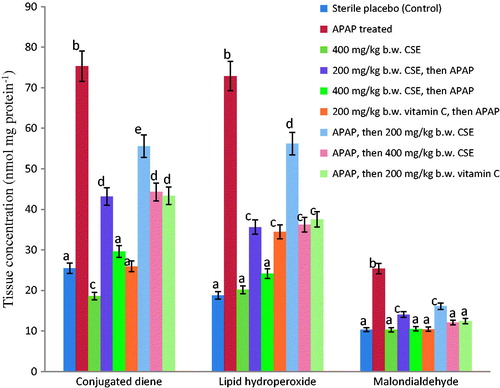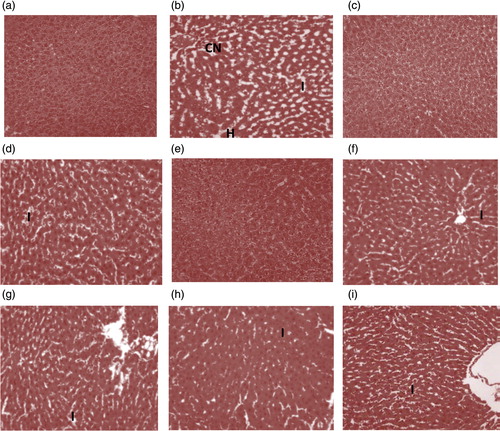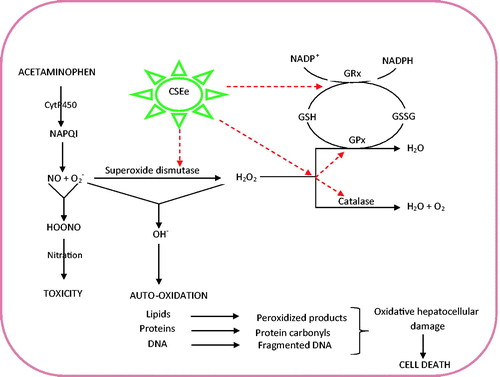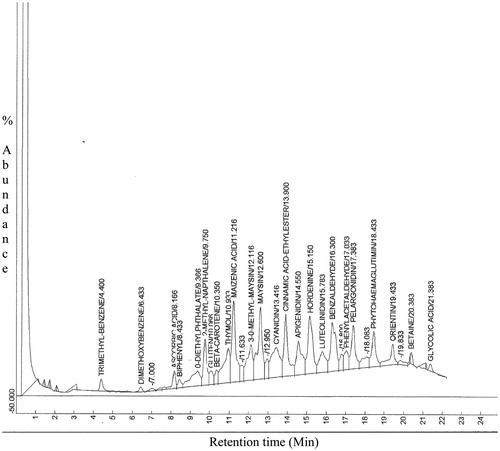Figures & data
Table 1. Effect of Zea mays, Stigma maydis aqueous extract on serum activities of liver function enzymes of APAP-treated rats (n = 6, Mean ± SEM).
Table 2. Effect of Zea mays, Stigma maydis aqueous extract on serum concentrations of albumin, bilirubin and total protein of APAP-treated rats (n = 6, mean ± SEM).
Table 3. Mean percentage protection offered by Zea mays, Stigma maydis and vitamin C against APAP-induced hepatic injury on some liver function parameters.
Figure 1. Effect of Zea mays, Stigma maydis aqueous extract on tissue concentrations of conjugated dienes, lipid hydroperoxides and malondialdehyde of APAP-treated rats. Values are mean ± standard deviation (SEM) of six determinations. abcdeBars with different superscripts for each parameter are significantly different (p < 0.05). APAP: acetaminophen; CSE: corn silk extract.

Table 4. Effect of Zea mays, Stigma maydis aqueous extract on specific activities of enzymic antioxidant system of APAP-treated rats (n = 6, mean ± SEM).
Table 5. Effect of Zea mays, Stigma maydis aqueous extract on the levels of non-enzymic antioxidant system, protein carbonyl and fragmented DNA of APAP-treated rats (n = 6, Mean ± SEM).
Figure 2. Liver micrograghs (×400, haematoxylin and eosin stained) of (a) normal control rat, (b) hepatotoxic rat, (c) CSE (400 mg/kg b.w.) treated rat, (d) hepatotoxic rat pre-treated with CSE (200 mg/kg b.w.), (e) hepatotoxic rat treated with CSE (400 mg/kg b.w), (f) hepatotoxic rat pre-treated with vitamin C (200 mg/kg b.w.), (g) hepatotoxic rat post-treated with CSE (200 mg/kg b.w.), (h) hepatotoxic rat post-treated with CSE (400 mg/kg b.w.) and (i) hepatotoxic rat post-treated with vitamin C (200 mg/kg b.w.). CSE: corn silk aqueous extract; I: inflammation; CN: coagulative necrosis; H: haemorrhage.

Table 6. Histopathological grading of liver tissue sections of Zea mays, Stigma maydis aqueous extract treated animals.
Table 7. Bioactive constituents of Zea mays, Stigma maydis aqueous extract as revealed by GC-MS chromatogram.
Figure 4. Tentative mechanism of antioxidative and hepatoprotective potentials of Zea mays, Stigma maydis aqueous extract. The red dotted arrows represent sites of induction and optimization by CSE that consequently promote scavenging of O2- and OH−. This ultimately normalized and increased cellular reduced glutathione (GSH) concentration and facilitates its mobilization towards NAPQI detoxification and by extension stalling nitration. CSE: corn silk aqueous extract; GPx: glutathione peroxidase; GRx: glutathione reductase.


